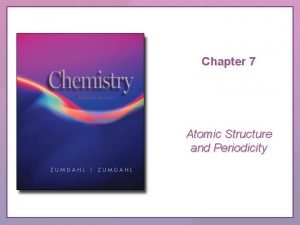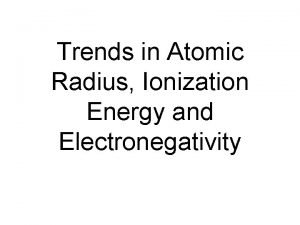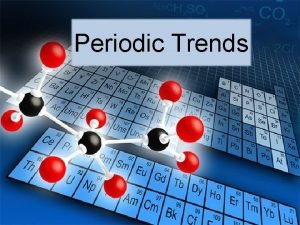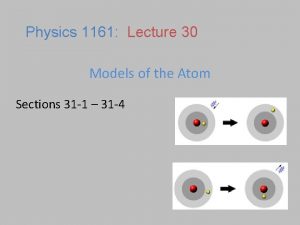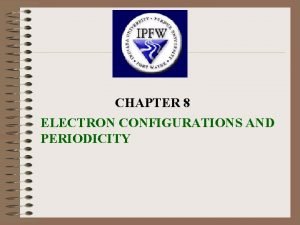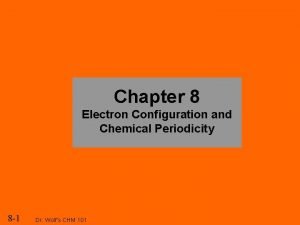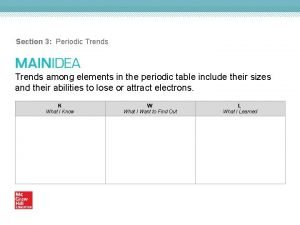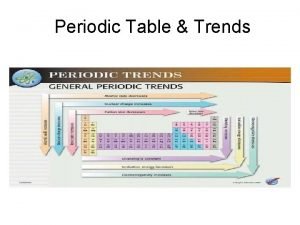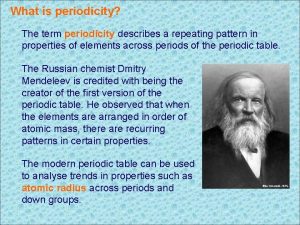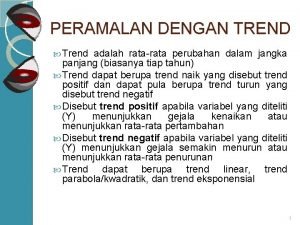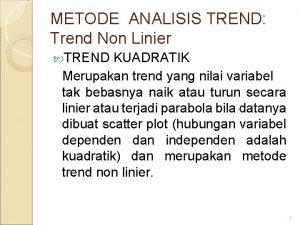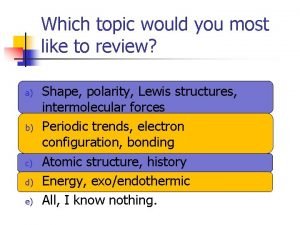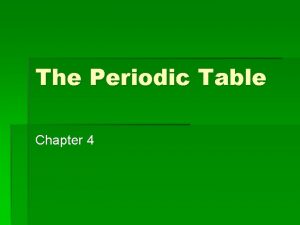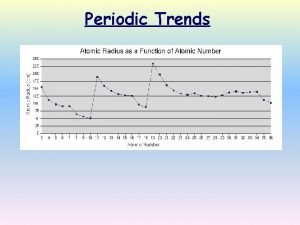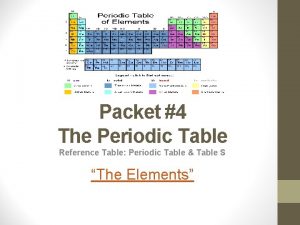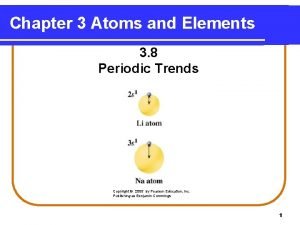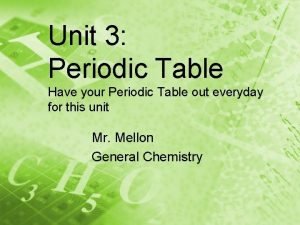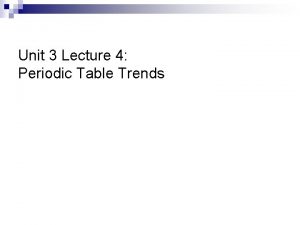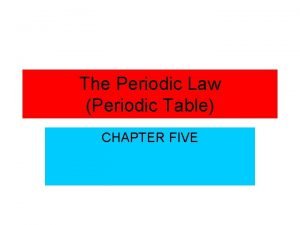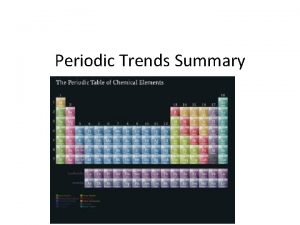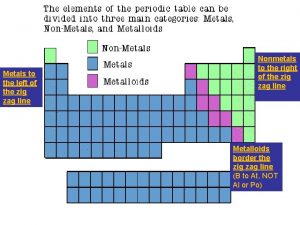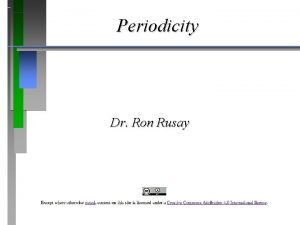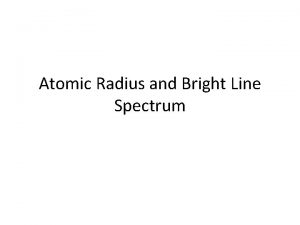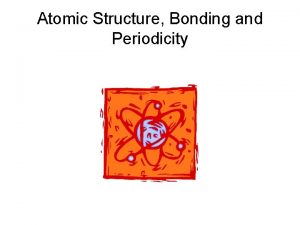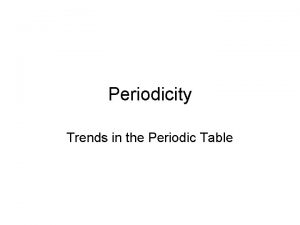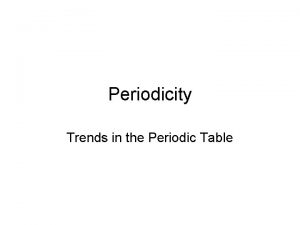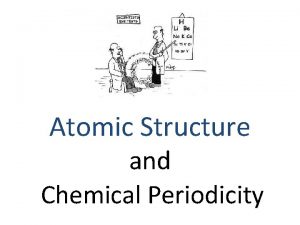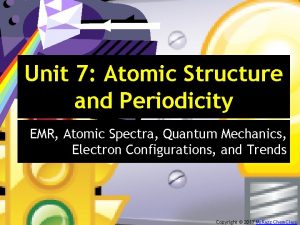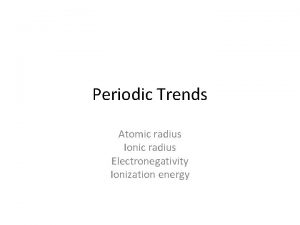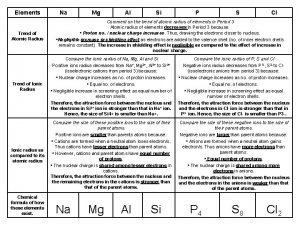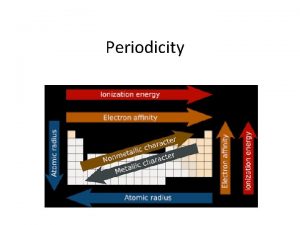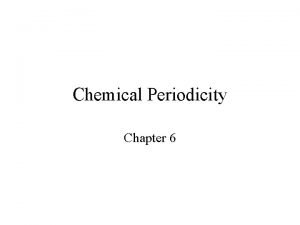Atomic Structure and Periodicity Trend in Atomic Radius








































- Slides: 40

Atomic Structure and Periodicity

Trend in Atomic Radius – Main Group • There are several methods for measuring the radius of an atom, and they give slightly different numbers. ü Van der Waals radius = nonbonding ü Covalent radius = bonding radius ü Atomic radius is an average radius of an atom based on measuring large numbers of elements and compounds.

Trend in Atomic Radius – Main Group • Atomic radius decreases across period (left to right) ü Adding electrons to same valence shell ü Effective nuclear charge increases ü Valence shell held closer

Trend in Atomic Radius – Main Group • Atomic radius increases down group ü Valence shell farther from nucleus ü Effective nuclear charge fairly close

Periodic Trends in Atomic Radius

Quantum-Mechanical Explanation for the Group Trend in Atomic Radius • The size of an atom is related to the distance the valence electrons are from the nucleus.

Quantum-Mechanical Explanation for the Group Trend in Atomic Radius • The larger the orbital an electron is in, the farther its most probable distance will be from the nucleus, and the less attraction it will have for the nucleus.

Quantum-Mechanical Explanation for the Group Trend in Atomic Radius • Traversing down a group adds a principal energy level.

Quantum-Mechanical Explanation for the Group Trend in Atomic Radius • The larger the principal energy level an orbital is in, the larger its volume.

Quantum-Mechanical Explanation for the Group Trend in Atomic Radius • Quantum-mechanics predicts the atoms should get larger down a column.

Quantum-Mechanical Explanation for the Period Trend in Atomic Radius • The larger the effective nuclear charge an electron experiences, the stronger the attraction it will have for the nucleus.

Quantum-Mechanical Explanation for the Period Trend in Atomic Radius • The stronger the attraction the valence electrons have for the nucleus, the closer their average distance will be to the nucleus.

Quantum-Mechanical Explanation for the Period Trend in Atomic Radius • Traversing across a period increases the effective nuclear charge on the valence electrons.

Quantum-Mechanical Explanation for the Period Trend in Atomic Radius • Quantum-mechanics predicts the atoms should get smaller across a period.

Trends in Ionic Radius • Ions in the same group have the same charge. • Ion size increases down the column. • • • Higher valence shell, larger Cations are smaller than neutral atoms; anions are larger than neutral atoms. Cations are smaller than anions. • Except Rb+ and Cs+ bigger or same size as F− and O 2−. Larger positive charge = smaller cation • For isoelectronic species • Isoelectronic = same electron configuration Larger negative charge = larger anion • For isoelectronic species

Periodic Trends in Ionic Radius

Periodic Trends in Ionic Radius

Ionization Energy (IE) • Minimum energy needed to remove an electron from an atom or ion ü Gas state ü Endothermic process ü Valence electron easiest to remove, lowest IE ü M(g) + IE 1 M 1+(g) + 1 e– ü M+1(g) + IE 2 M 2+(g) + 1 e– ØFirst ionization energy = energy to remove electron from neutral atom, second IE = energy to remove from 1+ ion, etc.

Ionization Energy: the energy required to remove an electron from an atom Ø Increases for successive electrons taken from the same atom Ø Tends to increase across a period Ø Electrons in the same quantum level do not shield as effectively as electrons in inner levels, protons, Energy required Ø Irregularities at half filled and filled sublevels due to extra repulsion of electrons paired in orbitals, making them easier to remove Ø Tends to decrease down a group Ø Outer electrons are farther from the Nucleus, more shielding effect



Quantum-Mechanical Explanation for the Trends in First Ionization Energy • The strength of attraction is related to the most probable distance the valence electrons are from the nucleus and the effective nuclear charge the valence electrons experience.

Quantum-Mechanical Explanation for the Trends in First Ionization Energy • The larger the orbital an electron is in, the farther its most probable distance will be from the nucleus and the less attraction it will have for the nucleus.

Quantum-Mechanical Explanation for the Trends in First Ionization Energy • Quantum-mechanics predicts the atom’s first ionization energy should get lower down a column.

Quantum-Mechanical Explanation for the Trends in First Ionization Energy • Traversing across a period increases the effective nuclear charge on the valence electrons.

Quantum-Mechanical Explanation for the Trends in First Ionization Energy • Quantum-mechanics predicts the atom’s first ionization energy should get larger across a period.

Trends in Second and Successive Ionization Energies

Electron Affinity • Energy is released when an neutral atom gains an electron. CHANGE in ENERGY ü Gas state ü M(g) + 1 e− M 1−(g) + EA • Electron affinity is defined as exothermic (−), but may actually be endothermic (+). ü Some alkali earth metals and all noble gases are endothermic. Why? • The more energy that is released, the larger the electron affinity. ü The more negative the number, the larger the EA.

Trends in Electron Affinity • Alkali metals decrease electron affinity down the column. – But not all groups do – Generally irregular increase in EA from second period to third period • “Generally” increases across period – Becomes more negative from left to right – Not absolute – Group 5 A generally lower EA than expected because extra electron must pair – Groups 2 A and 8 A generally very low EA because added electron goes into higher energy level or sublevel • Highest EA in any period = halogen


Table of Electron Affinities

Electronegativity • The ability of an atom to attract bonding electrons to itself is called electronegativity. • Increases across period (left to right) and decreases down group (top to bottom) – Fluorine is the most electronegative element. – Francium is the least electronegative element. – Noble gas atoms are not assigned values. – Opposite of atomic size trend. • The larger the difference in electronegativity, the more polar the bond. – Negative end toward more electronegative atom.

Electronegativity Scale

Electronegativity Difference and Bond Type • If the difference in electronegativity between bonded atoms is 0, the bond is pure covalent. – Equal sharing • If the difference in electronegativity between bonded atoms is 0. 1 to 0. 4, the bond is nonpolar covalent. • If the difference in electronegativity between bonded atoms is 0. 5 to 1. 9, the bond is polar covalent. • If difference in electronegativity between bonded atoms is larger than or equal to 2. 0, the bond is“ 100%” ionic.

Summary of Periodic Trends In the locker

Bond Polarity

Bond Dipole Moments • Dipole moment, m, is a measure of bond polarity. – A dipole is a material with a + and − end. – it is directly proportional to the size of the partial charges and directly proportional to the distance between them. • m = (q)(r) • Not Coulomb’s law • Measured in Debyes, D • Generally, the more electrons two atoms share and the larger the atoms are, the larger the dipole moment.


Magnetic Properties of Transition Metal Atoms and Ions • Electron configurations that result in unpaired electrons mean that the atom or ion will have a net magnetic field; this is called paramagnetism. –Will be attracted to a magnetic field

Magnetic Properties of Transition Metal Atoms and Ions • Electron configurations that result in all paired electrons mean that the atom or ion will have no magnetic field; this is called diamagnetism. –Slightly repelled by a magnetic field
 Ap chemistry chapter 7
Ap chemistry chapter 7 Oxygen periodic trends
Oxygen periodic trends Chapter 7 atomic structure and periodicity
Chapter 7 atomic structure and periodicity Atomic radius chart
Atomic radius chart Atomic radius trend
Atomic radius trend Atomic radii and electronegativity
Atomic radii and electronegativity 12 electrons
12 electrons Whats the trend for atomic radius
Whats the trend for atomic radius Trends in the periodic table of elements
Trends in the periodic table of elements Atomic number vs atomic radius
Atomic number vs atomic radius Formula for bohr radius
Formula for bohr radius 1s 22 s22 p63 s23 p64 s2
1s 22 s22 p63 s23 p64 s2 Electron configuration and chemical periodicity
Electron configuration and chemical periodicity Ionic radius trends
Ionic radius trends Ionic radius trend
Ionic radius trend Labster periodic table answers
Labster periodic table answers What is periodicity
What is periodicity Texas health steps check up forms
Texas health steps check up forms Monophagic
Monophagic Chemsheets periodicity
Chemsheets periodicity Aap bright futures periodicity schedule
Aap bright futures periodicity schedule Wuchereria bancrofti periodicity
Wuchereria bancrofti periodicity Contoh soal trend parabola
Contoh soal trend parabola Contoh soal metode kuadratik
Contoh soal metode kuadratik Smallest atomic radius
Smallest atomic radius Largest atomic radius
Largest atomic radius Nuclear charge periodic trend
Nuclear charge periodic trend Atomic radius definition
Atomic radius definition Largest atomic radius
Largest atomic radius Periodic table refrence table
Periodic table refrence table Chlorine sodium bromide
Chlorine sodium bromide Orbital diagram for na
Orbital diagram for na Do metals have high ionization energy
Do metals have high ionization energy Atomic radius snowman
Atomic radius snowman Atom definition
Atom definition Atomic radius pattern
Atomic radius pattern Atomic radius analogy
Atomic radius analogy Which element has the lowest ionization energy
Which element has the lowest ionization energy Atomic radius summary
Atomic radius summary Atomic radius
Atomic radius Valence electrons defintion
Valence electrons defintion


